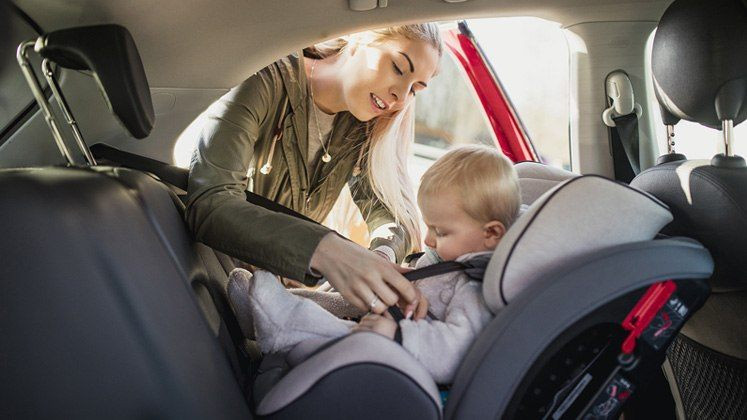Baby on Board: In-Car Safety with Little Ones
Purchasing a car seat is probably one of the most daunting shopping experiences for new parents: in this blog post we try and demistify the process, giving you the essential information plus a few handy tips on installation and use!
First of all, a reminder: children should always travel in the back of the car, away from active airbags and the dashboard. There is now a penalty for drivers who place a rearward-facing child car seat in the front where there is an active airbag. According to Irish law, all children under 150cms in height or 36kgs (79lbs) in weight must use a child restraint system (CRS) suitable for their height and weight while travelling in a car or goods vehicle (other than a taxi). The car seat should be used for every journey your child makes, no matter how short.
A car seat should always suit your child’s age and weight and must conform to the European safety standards ECE R44 03 & ECE R44 04 (look for the ‘E’ symbol) and since 2015 ECE R129 (for i-Size seats).
Babies start out in infant-only (rear-facing) seats or convertible seats, like the Britax Romer Dualfix Black or the Joie Stages Group 0+/1/2 Coal. As they grow, children switch to forward-facing seats like the Britax Romer Evolva 1-2-3 Black, and then to older kids’ seats like the Britax Romer Kidfix III Sict Black. At inhealth.ie you will find car seats from top quality brands such as Britax and Joie suitable all the way up to 12 years, when it’s usually time to move to a booster seat. Here's a quick rundown of which seat to use when:
- Group 0 - rearward facing baby seat - birth to 10kg (13kg for ‘0+’)
- Group 1 - rearward or forward facing child seat - 9-18kg
- Group 2 - high-backed booster seat without harness - 15-25kg
- Group 3 - booster cushion - 22-36kg
ISOFIX is the industry standard for solid child seat mounting points integrated with a car’s body structure. Not all child seats use ISOFIX mountings, but those that do are easier to correctly fit than those that rely solely on seat belt restraint.
i-Size is a European standard for car seats and came into effect in July 2013 where the child's height, not weight, is the deciding factor to determine what car seat is best suited for them. Please note that i-Size seats are only compatible with cars that have Isofix mounting points.
An important point to mention is that you should never buy a second hand car seat: there is a risk it might be damaged, and this may not be immediately obvious.
Once you have your car seat, ensure that you know how to correctly install it by following the instruction manual provided. Give yourself plenty of time to install it, well ahead of any journey.
A very common mistake is the seat belt not being pulled tight enough when the child seat is fitted. The child restraint should not wobble or move more than one inch. A good trick to achieve this is by kneeling on the seat with all your weight as you tighten up the belt. If the belt has been pulled as tight as possible and the seat still wobbles, it’s likely that it has not been fitted correctly, or that it is not compatible with your car.
Another important thing to check is that the seat-belt buckle should not rest against the frame of the car seat, as it could break.
Advice & articles
-
Lulla Doll : Your Baby’s Sleep Companion, Backed by Science!
19th Nov 2024Introducing the NEW Lulla Doll!Lulla Doll is a multi-award winning baby sleep aid that's suitable f
-
How to Cope With Back Pain During Pregnancy
9th Nov 2024Suffering from back pain during pregnancy? It's one of the most common complaints, especially toward
-
Introducing Zita West - The Must Have For Conception, Fertility and Postpartum!
2nd Nov 2024Zita West has landed at InHealth.ie!If you’re a woman couple in Ireland looking for guidance you ca
- Read more articles




